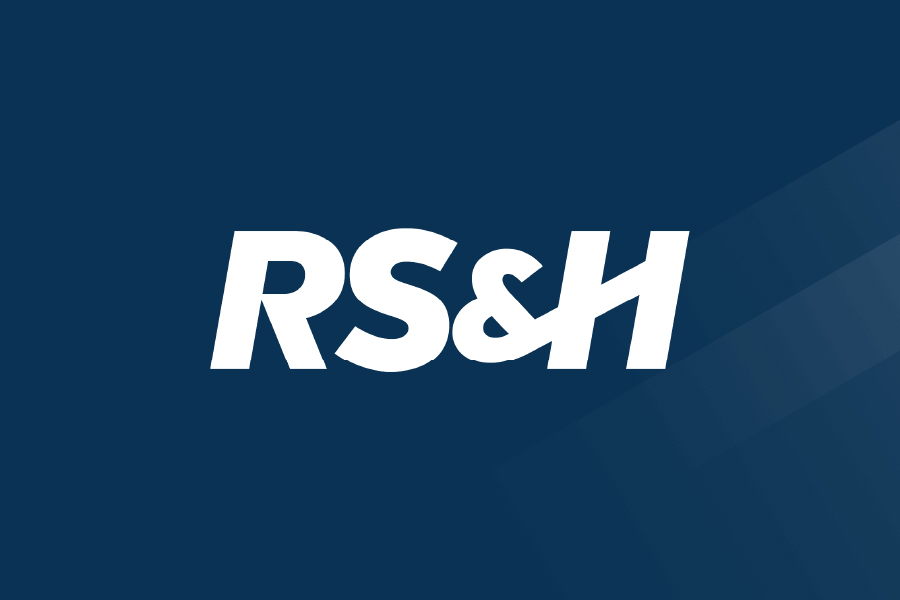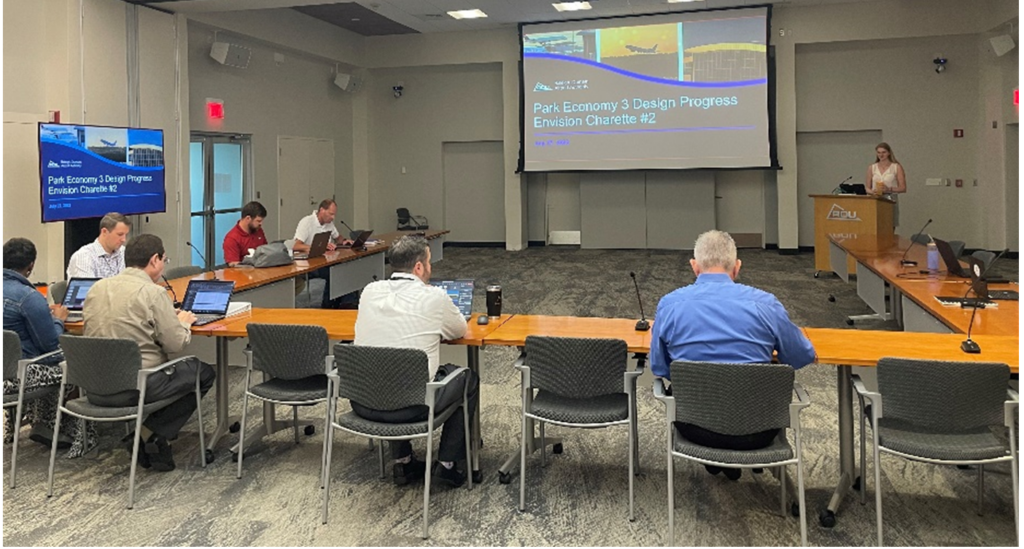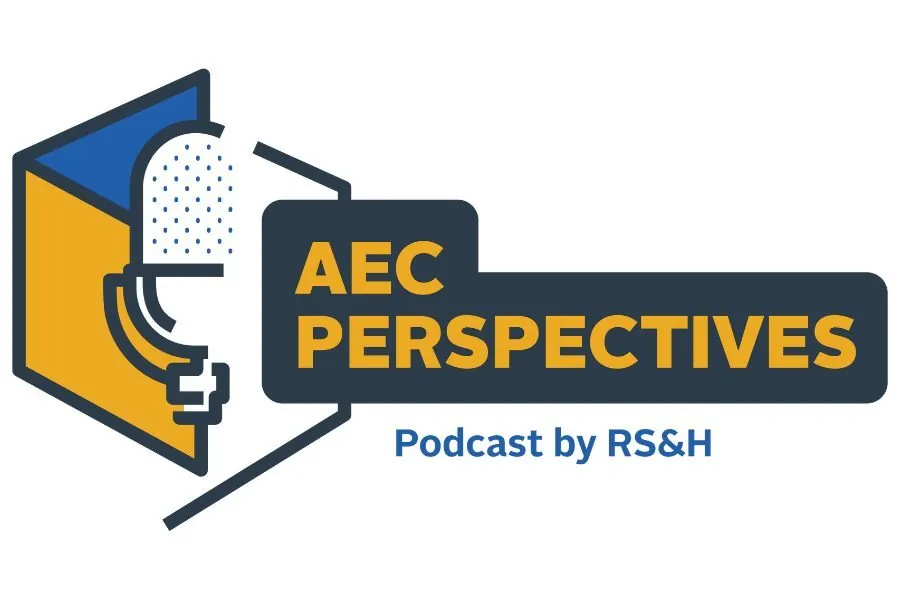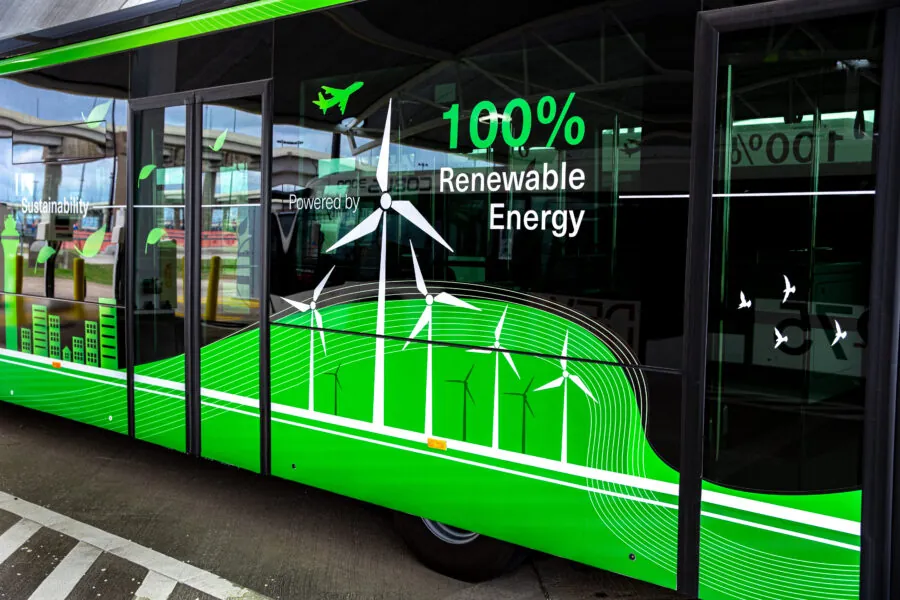Transforming Airports with Envision: A Journey Towards Sustainability and Resilience

The importance of sustainability – optimizing economic, social, and environmental performance — in today’s world cannot be overstated. For airports, embracing sustainability has become critical to reduce their carbon footprint, creating more resilient facilities, and increasing equity and social responsibility in host communities.
One tool airports can use to achieve project sustainability goals is the Institute of Sustainable Infrastructure’s (ISI) Envision® Sustainability Rating System. Envision® is a rating system for assessing the sustainability of civil infrastructure projects based on a system of credits, like the LEED framework for buildings. Within the Envision® framework, there are five credit categories: Quality of Life, Leadership, Resource Allocation, Natural World, and Climate and Resilience. Project teams can choose to pursue any of the established credits, and based on the level of achievement in each credit, the project will be awarded a score.
Envision® can apply to different airport project types, ranging from small general aviation airports to large hub international airports. Many common strategies implemented in projects utilizing the Envision® framework include:
- Implementing improvements to safety beyond what is minimally required by FAA or other regulatory requirements
- Developing long-term maintenance plans for airfield pavement or stormwater controls
- Considering ways to implement renewable energy technologies or alternative fuels during the construction or operations phases of a project
- Collaborating with the contractor to identify ways to improve construction safety
- Reducing construction waste, water use, and energy consumption
- Conducting public engagement activities to understand stakeholder concerns and incorporating feedback into the design
- Incorporating LED lighting and other measures to reduce long-term maintenance and cost
These strategies are widely accepted and implemented due to their alignment with a triple bottom line approach. These actions not only improve environmental and social outcomes for the surrounding community, but they also lead to cost savings for the airport, including reduced maintenance and longer lasting materials, lower construction costs, and decreased liability from safety incidents.
While there are numerous opportunities to integrate Envision® into airport improvement projects, obtaining Envision® verification continues to pose unique challenges compared to typical municipal infrastructure projects. Restricted public access, along with Federal Aviation Administration (FAA) standards contribute to these challenges. Without careful consideration, airfield projects can struggle to achieve the same level of sustainability as other infrastructure projects. Recognizing this difficulty, the ISI initiated a committee in collaboration with consultants in the AEC industry to develop solutions to integrate sustainability more seamlessly into airport projects. RS&H serves as a member of this committee to improve ISI’s understanding of airports and drive increased interest in Envision® among airport clients.
As a result of these difficulties, airports have begun to take a programmatic approach to sustainable infrastructure. For example, RS&H has developed sustainable design and construction guidance for airports to streamline integration with capital improvement programs. We are also supporting airports with integrating sustainability principles and programs such as landscaping policies or construction requirements into sustainable master or management plans to meet ambitious sustainability goals. Rather than creating new policies or documentation for each individual project, the programmatic approach enables airports to efficiently navigate the Envision® process while elevating innovation and achieving goals more quickly and economically. One application of Envision® at the programmatic level occurred at the Tampa International Airport (TPA).
Achieving Envision® Verification for Tampa International Airport (TPA)
RS&H led TPA’s Envision® verification process for their Phase 1 Master Plan (MP1) program. When RS&H and TPA began collaborating on an update of its 2014 Sustainable Management Plan (SMP) in 2018, the team ambitiously identified the nearly $1B MP1 program for Envision® verification to test TPA’s sustainability performance to date. This approach meant launching a complex verification effort that bundled the main terminal, rental car facilities, roadway and curbside areas, transit, long-term parking, and airside enhancements after completion of design and construction. This successful process is a compelling testament to the effective integration of sustainability practices into past development. It is also informing TPA’s approach to sustainability into the next decade via its immanent SMP update.
Highlights of the team’s creative approach to this big challenge include preserving historic and cultural resources, a credit opportunity under Envision®’s Quality of Life category. Even though airports are not typically considered historic or cultural resources, TPA has allocated substantial funding to showcase captivating public art installations and operate an onsite greenhouse. RS&H meticulously documented the extensive measures TPA took to prioritize public art and nature and elevate their significance. The project successfully achieved maximum points in the corresponding credit category.
The airport also prioritized addressing climate threats and vulnerabilities. RS&H was able to conduct an in-depth action plan to tackle airport-wide climate change impacts. In addition to earning Envision® credit, this vulnerability assessment and adaptation action plan proved invaluable during the 2022 hurricane season when Ian was predicted to hit the Tampa Bay area. The airport used the results of the study to help address vulnerabilities and prepare for landfall. Fortunately, the area was not significantly affected by Ian; however, we continued to collaborate with TPA to advance the airport’s resilience planning and integration efforts.
Collaboration as a Key Pillar of Envision®
Collaboration which begins in the early planning and design phases and continues through construction and operation of the project is critical to ensure the successful implementation of sustainability strategies. The collaborative process typically begins with meetings to consider the sustainability implications of various alternatives and how to incorporate public feedback from regulatory review periods. Early in the project lifecycle, a sustainability commitment statement and a sustainability management plan for the project will also typically be made through collaboration with the contractor and the client. These elements lay the foundation for collaborative dialogue and problem-solving between the designers, the contractor, and the owner.

RS&H leading an Envision® design charrette
One of the best collaboration tools is the Envision® design charette. These meetings are attended by representatives from multiple business units within the airport, the contractor, various subconsultants, and the design team. By amplifying many diverse perspectives, these charettes promote creative problem-solving and allow the team to produce solutions that balance economic, social, and environmental priorities. Charettes are also useful for promoting innovation and new idea development, which could lead to new opportunities for design improvements, external partnerships with local universities and other organizations, and standards and guidelines for future projects.
Courtney Gantt, an Environmental Consulting Associate in RS&H’s Raleigh, NC office, knows firsthand the importance of a design charette when working towards Envision® verification.
“To have so many project team members – from electrical designers to construction managers – approach me with innovative sustainability ideas is what makes my job so special and truly elevates the uniqueness of my role. I have a profound sense of purpose because it feels like everyone is on this transformative journey together. We’ve learned that it’s not about checking the boxes for sustainability – it’s about finding next-level solutions to social, economic, and environmental challenges. When sustainable and resilient design becomes one of the fundamentals, we can achieve big goals,” proclaims Courtney.
Envision® into the Future
Every project is unique and presents its own set of challenges. Some projects have unique permitting requirements or extended public participation periods while other projects have expedited schedules and quicker design phases. It’s noteworthy that projects in areas with heightened local and state environmental regulations or larger projects often have more opportunities for achieving Envision® credits since sustainability considerations and actions are often mandatory. In these cases, Envision® can be integrated into established frameworks, planning processes, and design and construction phases. For other projects, it is necessary to demonstrate the economic viability of sustainability initiatives or commit to advanced sustainability and resilience programs since regulatory requirements are not driving implementation.
At RS&H we’re helping clients achieve an Envision® verification by:
- Foster collaboration through the planning and design phases to assess alternatives
- Review ways to reduce impacts to the community and the environment during construction
- Plan, develop documents and manage sustainability implementation throughout the project lifecycle
The journey toward sustainability requires collaboration, innovation, and a commitment to making a positive impact. By providing expertise, fostering collaboration, and maximizing opportunities, RS&H remains dedicated to assisting airport clients with out-of-the-box thinking and unconventional approaches to sustainable design and construction using tools like Envision® to ultimately shape the future of sustainable airport infrastructure.
RS&H and our clients are leading the charge by integrating Envision® into airport development projects. Reach out to learn how our team can support your goals.





